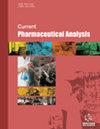Formulation, Analytical Method Development and Validation of an Emulsion of Multi-Enzyme with Carminative Oils
IF 1.5
4区 医学
Q4 PHARMACOLOGY & PHARMACY
引用次数: 0
Abstract
Introduction:: Indigestion leading to Flatulence is a common problem for infants, and tackling it is tedious for the parents. So, addressing the issue with an ideal formulation should likely have a combination of digestive enzymes and carminatives. Method:: A formulation containing enzymes like Fungal Diastase (Amylase) and Papain (Protease) for the digestion of Carbohydrates and Protein, respectively, along with aromatic, volatile, carminative oils like Dill Oil, Anise Oil, and Caraway Oil can serve the purpose to mitigate problems associated with infant indigestion and flatulence with maximum compliance. Result:: The stability of multi-enzyme and analysis of carminative oil mixtures still need to be improved due to their inherent characteristics. Enzymes are very likely susceptible to changes in temperature and pH, while the solubility of carminative oils is minimal in the aqueous phase. Also, each enzyme is stable in different pH ranges. Nine emulsions were developed using a suitable buffer system and analyzed by HPLC method. Conclusion:: The optimum pH range was found, and analytical method validation was done for the method's accuracy, precision, and repeatability. The optimum pH was 6-6.5, and the active pharmaceutical ingredients (API) assay was found within the acceptable limit of NLT, 90% for enzymes and 90-110% for carminative oils.多种酶与香油乳液的配方、分析方法开发与验证
简介::消化不良导致胀气是婴儿的常见问题,解决这个问题对父母来说非常繁琐。因此,要解决这个问题,理想的配方应该是消化酶和催吐剂的组合。方法:配方中含有分别用于消化碳水化合物和蛋白质的酵素,如真菌淀粉酶(淀粉酶)和木瓜蛋白酶(蛋白酶),以及芳香、挥发性的催眠油,如莳萝油、八角油和茴香油,可以最大程度地缓解婴儿消化不良和肠胃胀气的相关问题。结果::由于多酵素的固有特性,其稳定性和催眠油混合物的分析仍有待改进。酶极易受温度和 pH 值变化的影响,而催吐油在水相中的溶解度很小。此外,每种酶在不同的 pH 值范围内都很稳定。使用合适的缓冲体系研制了九种乳剂,并采用高效液相色谱法进行了分析。结论找到了最佳 pH 值范围,并对分析方法的准确性、精确性和重复性进行了验证。最佳 pH 值为 6-6.5,活性药物成分(API)的检测结果在 NLT 的可接受范围内,酶的检测结果为 90%,催眠油的检测结果为 90-110%。
本文章由计算机程序翻译,如有差异,请以英文原文为准。
求助全文
约1分钟内获得全文
求助全文
来源期刊
CiteScore
1.50
自引率
0.00%
发文量
85
审稿时长
3 months
期刊介绍:
Aims & Scope
Current Pharmaceutical Analysis publishes expert reviews and original research articles on all the most recent advances in pharmaceutical and biomedical analysis. All aspects of the field are represented including drug analysis, analytical methodology and instrumentation. The journal is essential to all involved in pharmaceutical, biochemical and clinical analysis.

 求助内容:
求助内容: 应助结果提醒方式:
应助结果提醒方式:


